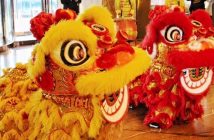
We all know that Spring Festival, Chinese New Year, is the most important annual celebration for the Chinese. But do you know why people suddenly all dress in red? Or why all the doors are pasted with red decorations? Why is the occasion marked with a big dinner for and fireworks? Why is Spring Festival, or chunjie (春节), also called guonian (过年), which literally means "survive the year"?
To find the answers to these questions we must look to a tale about the devastating beast Nian, a word that also means "year" in Chinese.
It is said that in ancient times there was a fierce and violent beast called Nian (年兽) who lived deep under the ocean. At the end of each lunar year it would come out to destroy crops and eat animals and people in the village at night. The people were so frightened that they would flee from their homes every year to hide in a safe place, the time which is now the Spring Festival.

However, an old man from outside the village came to visit on the last day of the year. As everybody fled, he showed no interest in escaping with the others and sheltered in a granny’s house by himself. He promised the villagers to drive the beast away.

That night, which is now Spring Festival Eve, Nian showed up as ever, but something had changed. Red papers were pasted on the gate of the granny’s house and the room was lit bright with lanterns, which was imitated the daylight that the beast despised.
When Nian attempted to angrily storm into the house, the loud cracking sound of fireworks (yanhua, 烟花) exploded out and Nian trembled in fear and finally gave up his attack.

The villagers returned the next day and were surprised to find the old man still alive. After sharing the secret of scaring away the beast, the villagers got dressed in new clothes and sent their regards to friends and families. Each family also decided to cook a big dinner to celebrate surviving Nian.
This story gave birth to many of the Spring Festival traditions, including wearing red clothes, putting red decorations on doors, lighting the house in brightly colored lanterns, and setting off firecrackers.

It was said that Nian never bothered the village again, although it was believed to have lived on from the encounter.
Click here to watch a play (in English) of the Nian story performed by a group of Chinese students, and here for a cartoon video (in Chinese).
Photos: screen grab



